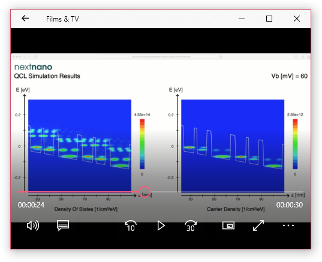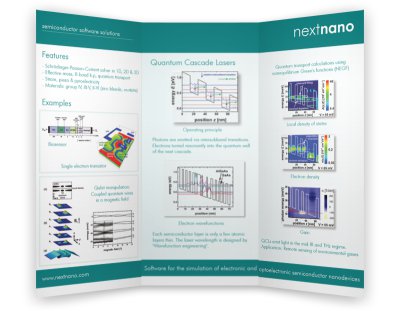Quantum-Cascade Lasers (QCLs) are a type of semiconductor laser that emits in the mid- to far-infrared range of the electromagnetic spectrum. They were initially demonstrated by Jérôme Faist, Federico Capasso, Deborah Sivco, Carlo Sirtori, Albert Hutchinson, and Alfred Cho at Bell Laboratories in 1994.
Unlike traditional interband semiconductor lasers, which emit radiation by recombining electron-hole pairs across the material's band gap, QCLs operate based on unipolar emission. Laser emission is achieved by utilizing intersubband transitions in a stacked structure of semiconductor multiple quantum well heterostructures.
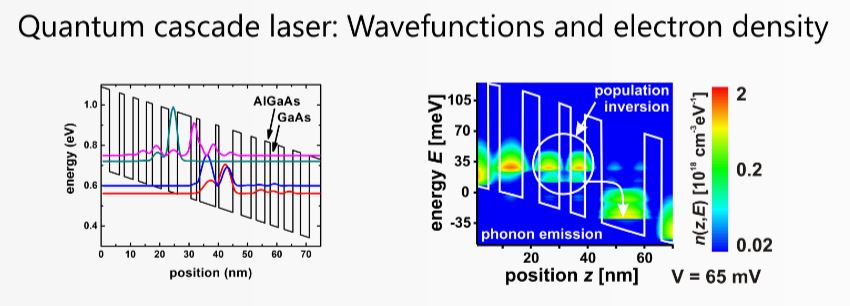
Download nextnano.NEGF software
- Nonequilibrium Green's function (NEGF) method for calculating I-V curves and gain
- NEGF quantum transport based on the code written by Thomas Grange
- Documentation
-
Download nextnano.NEGF including an evaluation license for a few months.
Video
This video (mpg4, 23 MB) shows how a QCL works. The first 10 seconds summarize the features of our software, the remaining 20 seconds show the animated simulation results. At 20 seconds, the QCL starts to lase: The electron density (figure on the right) shows the population inversion, i.e. the higher state has a larger electron population than the lower lasing state.
Leaflet on QCL simulations
Information on nextnano software for QCLs
(low resolution pdf)
(high resolution pdf)
Presentation
A good introduction into the nextnano.NEGF software is the tutorial talk Modeling electron transport in quantum cascade lasers given by Thomas Grange at the International Quantum Cascade Laser School and Workshop (Cassis/France, 2018).
Tutorials
-
nextnano.NEGF (NEGF)
THz GaAs/AlGaAs (Fathololoumi) -
QCL
Simple quantum cascade structure -
QCL
Quantum cascade laser -
RTD
This tutorial demonstrates the NEGF method with a Resonant Tunneling Diode (RTD) as an example.
If you are interested in further tutorials, please contact stefan.birner [at] nextnano.com.
InGaAs multiple quantum well

Intersubband transitions in InGaAs/AlInAs multiple quantum well systems
What you can learn:- single-band effective mass vs. 8-band k·p, InGaAs/AlInAs
- self-consistent Schrödinger-Poisson equation, 8-band k·p Schrödinger equation
Results
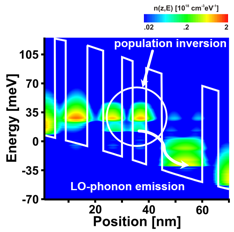
This figure shows the calculated electron density in a THz QCL.
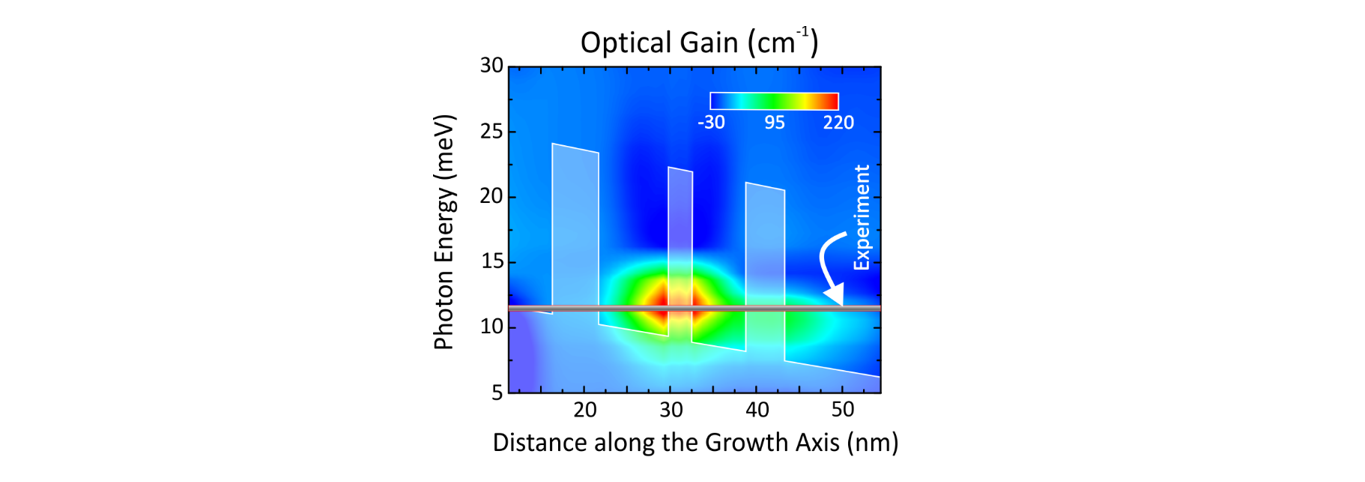
This figure shows the calculated gain of a THz QCL.
Features
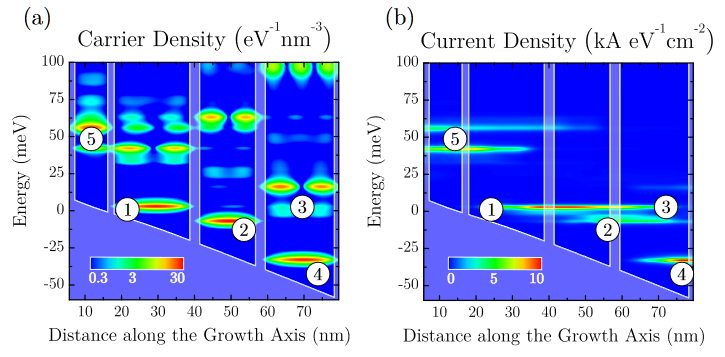
nextnano software for quantum transport
1) nextnano.NEGF
- Nonequilibrium Green's function (NEGF) method for calculating I-V curves and gain
- NEGF quantum transport based on the code written by Thomas Grange
- Documentation
-
Download nextnano.NEGF including an evaluation license.
nextnano.MSB
- Nonequilibrium Green's function (NEGF) method for calculating I-V curves and gain based on the multi-scattering Büttiker probe model (MSB)
- NEGF quantum transport based on the MSB method (code written by Peter Greck)
- nextnano.MSB
-
Download nextnano.MSB including an evaluation license until 2016-12-31.
2) nextnano3 & nextnano++
- self-consistent Schrödinger and Poisson equations
- 8x8 k.p Schrödinger equation
- strain
- Documentation (nextnano3)
- Documentation (nextnano++)
Publications
The following two papers give a very basic introduction to QCL modeling.
-
Simulation of quantum cascade lasers - optimizing laser performance
S. Birner, T. Kubis, P. Vogl
Photonik international 2, 60 (2008) -
Simulation zur Optimierung von Quantenkaskadenlasern
S. Birner, T. Kubis, P. Vogl
Photonik 1/2008, 44 (2008)
Our recent publications on QCL modeling:
-
Room temperature operation of n-type Ge/SiGe terahertz quantum cascade lasers predicted by non-equilibrium Green's functions
T. Grange, D. Stark, G. Scalari, J. Faist, L. Persichetti, L. Di Gaspare, M. De Seta, M. Ortolani, D. J. Paul, G. Capellini, S. Birner, M. Virgilio
Applied Physics Letters 114, 111102 (2019)
arXiv: https://arxiv.org/abs/1811.12879 -
Optimization of terahertz quantum cascade lasers by suppressing carrier leakage channel via high-energy state
T.-T. Lin, L. Wang, K. Wang, T. Grange, H. Hirayama
Applied Physics Express 11, 112702 (2018) -
Broadening mechanisms and self-consistent gain calculations for GaN quantum cascade laser structures
K. Wang, T. Grange, T.-T. Lin, L. Wang, Z. Jéhn, S. Birner, J. Yun, W. Terashima, H. Hirayama
Applied Physics Letter 113, 061109 (2018)
Poster
-
Non-equilibrium quantum transport theory for quantum cascade lasers
T. Kubis, C. Yeh, S. Birner, P. Vogl
Poster at the CLEO/Europe-IQEC 2007 conference
